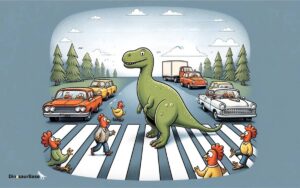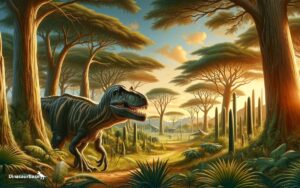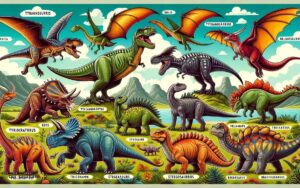How Did Birds Evolve from Dinosaur Ancestors: A Guide
Birds evolved from theropod dinosaurs during the Mesozoic Era. Feathered dinosaurs gradually developed flight capabilities leading to modern avian species.
Understanding the origins of birds unveils a captivating chapter in evolutionary history. The story begins over 150 million years ago, with theropods, a group of meat-eating dinosaurs that shared a remarkably similar skeletal structure to that of birds.
Paleontologists, studying fossils like Archaeopteryx, have traced this lineage, finding evidence of feathers and bird-like features long before birds took to the skies.
Key adaptations, such as feathers for insulation that later facilitated flight, lightweight hollow bones, and a unique respiratory system, were pivotal.
This evolutionary narrative not only enriches our knowledge of biodiversity but also underscores the dynamic, ever-changing nature of life on Earth.
The journey from dinosaur to bird is a testament to the power of gradual, persistent change over eons.

The Dawn Of Dinosaurs
Welcome to The Dawn of Dinosaurs, a fascinating era that gave rise to the rulers of the prehistoric world. Here, we delve into the origins of these magnificent creatures.
Birds, our feathered friends in the sky, are the living descendants of these giants. Let’s uncover how they evolved from their formidable ancestors.
Triassic Beginnings
The Triassic period marked the start of an evolutionary journey. It was a time of change for life on Earth.
Dinosaurs first appeared during this era, evolving from reptilian forebears. Amidst a backdrop of volatile environments, these creatures began their dominance.
- First dinosaurs: small, bipedal, and quick
- Variety of shapes and sizes: adaptation was key
Evolution fueled by survival:
- Rising and falling continents
- Changing climates
- New food sources
In these formative years, the foundation for avian descent was laid.
Predominance In The Jurassic
The Jurassic period saw the rise of dinosaurs to a dominant role. They became the apex predators and herbivores of their ecosystems.
| Feature | Jurassic Development |
|---|---|
| Size | Gigantic saurians like the Brachiosaurus took the stage |
| Flight | Early signs in theropods hinted at future abilities |
| Diversification | Dinosaurs evolved into a myriad of forms |
One crucial group, the theropods, showcased characteristics that would lead to birds. These included feathers for insulation and display.
From Scales To Feathers
The transition from scales to feathers marks one of the most fascinating evolutionary leaps in the animal kingdom.
This transformation was not sudden, nor was it mere happenstance; rather, a complex interplay of genetic, environmental, and selective pressures sculpted the early feathers from reptilian scales.
Deciphering this riddle takes us back in time to the age of dinosaurs, unearthing the connection between our modern avian friends and their ancient ancestors.
The Evolution Of Feathers
Imagine a time millions of years ago, when dinosaurs roamed the Earth. These creatures were not all the lumbering giants of popular imagination.
Among them, small theropods began to display unique integuments—what would eventually become feathers.
- Simple protofeathers: Similar to hair, offered insulation.
- Complex feathers: Developed aerodynamic properties.
Scientists have unearthed fossils displaying feather-like structures. These structures show step-by-step changes from scaly skin to sophisticated flight-capable feathers.
Key Points:
1. Insulation
2. Display
Traits Shared With Theropods
In examining how birds emerged from dinosaur roots, we find striking similarities. Birds share many traits with theropods, a clade of carnivorous dinosaurs.
| Trait | Theropod | Bird |
|---|---|---|
| Hollow Bones | Present | Present |
| Bipedal Locomotion | Present | Present |
| Opposable Second Toe | Present in some | Absent |
| Nesting Behavior | Evidence suggests | Present |
Fossils with preserved feathers and bird-like hips validate these shared features. Birds keep these ancient traits while having evolved unique adaptations for flight.
Archaeopteryx: The Missing Link
Imagine a creature with feathers like a bird but teeth and a tail like a dinosaur. This creature, Archaeopteryx, sparks wonder and curiosity.
Scientists call it the missing link between dinosaurs and birds. Let’s explore why Archaeopteryx holds a key to one of nature’s most fascinating transformations.
Dissecting Archaeopteryx Fossils
The discovery of Archaeopteryx fossils was a turning point in paleontology. These fossils give a clear look into the past. They show us how features of dinosaurs changed into those we see in birds today.
- Teeth and jaws similar to meat-eating dinosaurs
- Feathers for heat control or flight
- Long, bony tail like dinosaur ancestors
- Wings with flight feathers
Each fossil is a clue in a million-year-old mystery. They tell us how a flying animal evolved.
Bird-like Features Unveiled
Archaeopteryx bridges the gap between birds and dinosaurs. It shows both bird-like and dinosaur-like features. Its body is a roadmap of evolution.
| Bird-Like Features | Dinosaur Ancestors’ |
|---|---|
| Feathers | Scales |
| Lightweight Bones | Heavy Skeleton |
| Beak with No Teeth | Teeth and Jaws |
By studying these features, scientists understand how birds became separate from other dinosaurs. The story of birds is a tale of change, survival, and flight. Archaeopteryx shows us how this unfolded.
Dinosaur Survival And The Rise Of Birds
The story of the dino-to-bird evolution is a fascinating tale. It paints a picture of resilience and adaptability. Imagine powerful dinosaurs reigning supreme, then facing a challenge that reshapes life on Earth.
From these cataclysmic changes, birds emerge, descendants of the mightiest creatures that ever walked the planet.
Cretaceous-paleogene Extinction Event
Around 66 million years ago, a colossal impact event changes Earth’s course. This event causes massive extinctions, affecting nearly 75% of all species. It marks the end of the Cretaceous period and the reign of non-avian dinosaurs.
Thick dust clouds block the sun, disrupting food chains. As sunlight dims, global temperatures plummet. The survival game has new rules.
Avian Survivors And Radiations
Yet, in this post-apocalyptic world, some creatures thrive. Avian dinosaurs, or the first true birds, persist. Their small size, adaptations to diverse diets, and ability to fly help them survive.
Following the extinction event, these avian survivors find new opportunities. With fewer predators and abundant niches, they radiate into an array of species. This paves the way for the 10,000 bird species we see today.
| Step | Characteristic | Evolutionary Advancement |
|---|---|---|
| 1 | Hollow Bones | Reduce weight for flight |
| 2 | Feathers | Insulation and flight |
| 3 | Beaks | No teeth, lighter heads |
In this new dawn, various bird groups spread across the globe. They evolve unique features to survive different habitats. The radiation of birds fills the environment with song, color, and life. Our skies, forests, and oceans buzz with their descendants. It is a testament to life’s resilience in the face of adversity.
Examining The Fossil Record
Scientists have long been fascinated with the evolution of birds. To unravel this mystery, they turn to the most telling evidence: the fossil record.
This ancient archive, embedded in layers of rock, holds key insights into how birds emerged from their prehistoric dinosaur ancestors.
Techniques In Paleo-ornithology
Experts in paleo-ornithology use advanced techniques to study ancient bird fossils. They piece together clues from bones and feathers preserved in rock. Here’s how they do it:
- CT Scanning: This creates 3D images of fossils without damaging them.
- Isotope Analysis: It reveals details about prehistoric climates and diets.
- Laser-Stimulated Fluorescence: This method helps to uncover barely-visible details, like feather outlines.
Breakthrough Discoveries In Bird Evolution
The journey from dinosaurs to birds is documented through numerous fossils. Here are some breakthrough discoveries:
| Fossil Name | Age | Significance |
|---|---|---|
| Archaeopteryx | 150 million years | Known as the first bird, it shows a mix of avian and reptilian features. |
| Confuciusornis | 125 million years | One of the earliest birds with a beak and no teeth. |
| Vegavis | 70 million years | Displays features of modern waterfowl and suggests early diversification of birds. |
These finds are vital in understanding the transition from ground-dwelling dinosaurs to the first flapping birds.

Credit: news.utexas.edu
Modern Birds And Their Dino Dna
Many people wonder how the birds we see today are descendants of mighty dinosaurs. Understanding the transformation from ferocious beasts to feathered fliers is fascinating.
Dive into the world of ‘Modern Birds and their Dino DNA’ to discover the incredible journey of evolution.
Genetic Links To The Past
Recent scientific breakthroughs have revealed startling genetic similarities between modern birds and their dinosaur ancestors. Scientists extracted DNA from fossilized dinosaur bones. They compared it with DNA from today’s birds.
These comparisons provide concrete evidence that birds are direct descendants of theropods, a group of dinosaurs.
Birds carry the very essence of dinosaurs within their genes.
Dino traits visible in birds today include:
- Hollow bones – essential for flight
- Three-fingered hands – seen in wings
- Certain behaviors – like nest building
These similarities remind us of the dinosaur lineage every time a bird takes to the skies.
Continuous Evolution Of Avian Species
Birds didn’t just suddenly appear. They evolved over millions of years. Changes happened gradually through natural selection. The process sculpted their features for survival and flight.
Key evolutionary stages in birds include:
- Feather development – originated for warmth, became flight tools
- Skeleton lightening – bones became lighter for flight efficiency
- Beak formation – replacing teeth to reduce weight
All these changes link back to their dinosaur heritage. Archaeopteryx, often cited as the first bird, showcases many of these transitions. Modern birds, like the majestic Eagle or the swift Hummingbird, are dinos’ living relatives.
Each bird we see is a tribute to the power of evolution.
Frequently Asked Questions On How Did Birds Evolve From Dinosaur Ancestors: A Guide
How Did Dinosaurs Evolve To Birds?
Dinosaurs evolved into birds through gradual anatomical changes over millions of years. Feathered theropods, a dinosaur subgroup, are the direct ancestors of modern birds, having developed features like wings and lightweight skeletons for flight.
What Is The Theory That Birds Evolved From Dinosaurs?
The theory that birds evolved from dinosaurs is known as the “Dinosaur-Bird Evolution Theory. ” It posits that modern birds are descendants of small, feathered, theropod dinosaurs.
Why Do Paleontologist Think Birds Evolved From Dinosaurs?
Paleontologists believe birds evolved from dinosaurs due to shared physical features, such as feathers, and fossil evidence linking theropods to avians.
What Evidence Supports The Hypothesis That Birds Evolved From Dinosaurs?
Several key pieces of evidence support the hypothesis that birds evolved from dinosaurs. Fossils show similarities in skeletal structure between birds and theropod dinosaurs. Feathered dinosaur specimens connect the evolutionary dots to modern birds. Finally, both share traits like nesting behaviors and brooding.
Conclusion
The journey from ancient dinosaurs to the birds perching outside our windows is truly fascinating. Unraveling this evolutionary tale helps us appreciate the complexity of nature and the marvels of adaptation. Remember, next time you spot a bird, you’re witnessing a living legacy of the prehistoric past.
Nature’s tapestry is rich—each bird a thread woven from the fabric of the age of dinosaurs.




